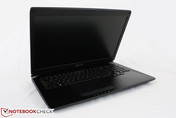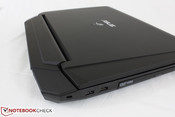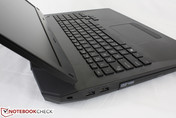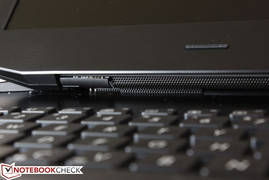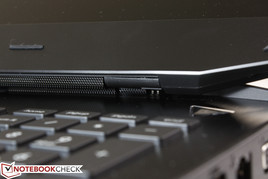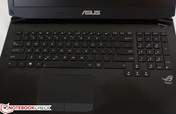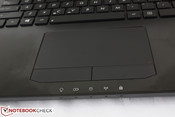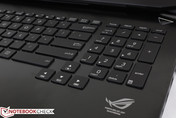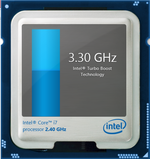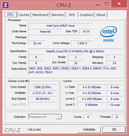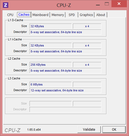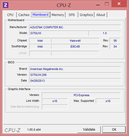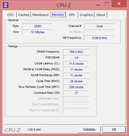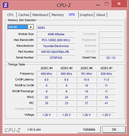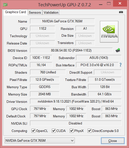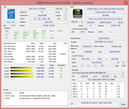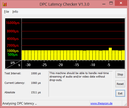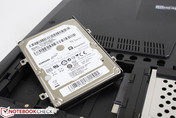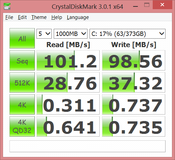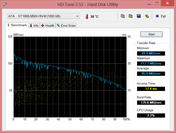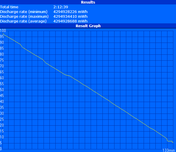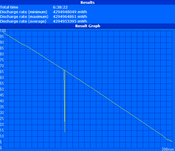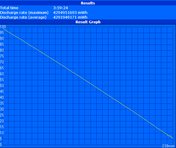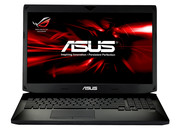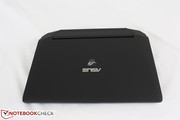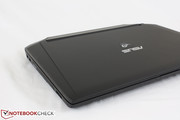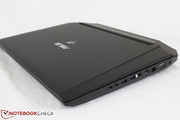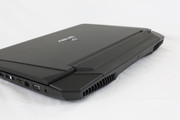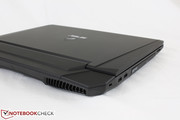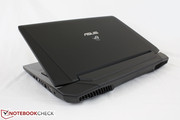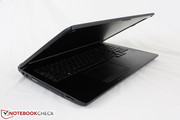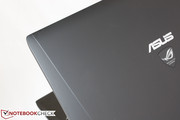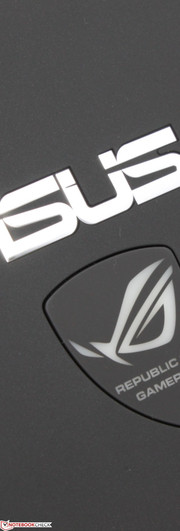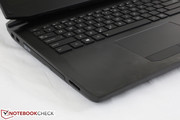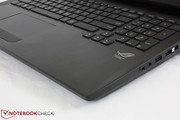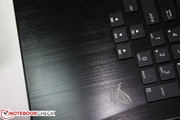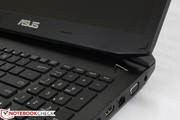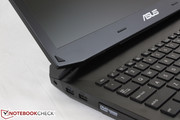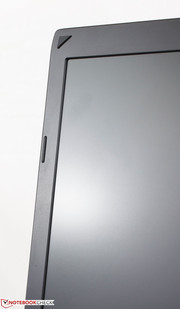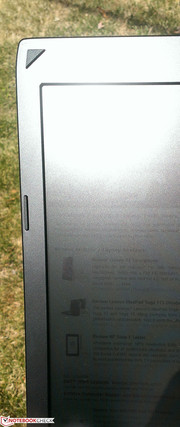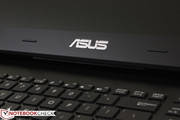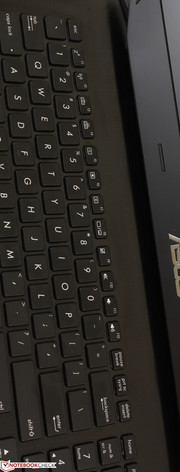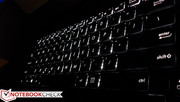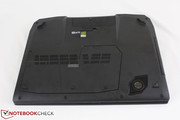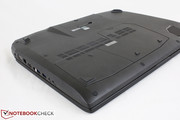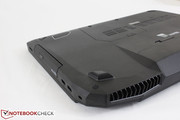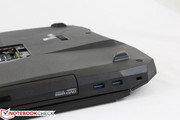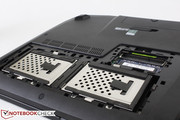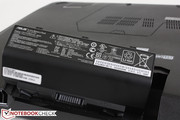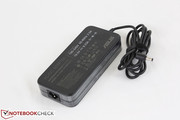Review Asus G750JW Notebook

Hardcore gamers in need of a satisfying mobile gaming fix have plenty of options ranging from direct barebones and system resellers to specific series or models under exclusive branding. The Republic of Gamers (ROG) G series falls under the latter category as part of Asus’s dedicated lineup of gaming notebooks. Notebookcheck has reviewed most every major G Series model since the G1 back in 2007 up to the first 14-inch ROG model late last year, so we’re certainly treading familiar territory yet again with the manufacturer's latest release following the launch of both Haswell and the refreshed Kepler silicon.
The new G750 series is an update to the previous 2012 G75 series and reequips the interior with Core ix-4xxx CPUs and GTX 7xxM graphics with some notable exterior changes. We have on hand the G750JW model with a Core i7-4700HQ CPU, GTX 765M GPU, 12 GB RAM and a 1 TB HDD for a retail price of $1399. Other configurations exist such as the higher-end G750JH with RAID 0 SSDs and a GTX 780M for $2499, though this will not be available until August at the earliest. Our preview on a G750JX pre-production unit earlier last month left us good impressions as have most ROG models to date, but that has in turn raised our expectations for this latest generation. We take the 2013 G750JW ROG through our usual comprehensive tests in our full review below.
Case
Asus ROG models are instantly recognizable due to the encompassing jet black design that is so commonly compared to modern jet fighters. In contrast to the usually boxy or dull barebones, the G750 series has sharper edges and corners for a leaner and meaner visual appeal that correlates well with the processing power inside. In fact, Asus has managed to oh so slightly reduce the thickness (50 mm vs. 52 mm) of the G750 from its previous G75 iteration, though its weight of 4.5 kg still comes in noticeably heavier than a number of other 17.3-inch gaming models like the iBuyPower CZ-17 (4.0 kg) and MSI GT70H (3.8 kg).
The new Asus model is visually identical to the 14-inch G46 and utilizes a more unibody-like construction compared to the older G75 where the surrounding keyboard surface is a distinctly separate panel from the adjacent speakers and palm rests. The entire surface is now slightly inclined and is simply a single glossy brushed aluminum panel, which contrasts well to the largely untouched rubberized matte outer lid and tough plastic underside. Gone are the streaks of silver and gray for an all black and chrome-free exterior that looks great at the trivial cost of attracting difficult-to-clean fingerprints.
Construction quality is strong around the base with little to no give on the palm rests and center of the keyboard. The outer lid could have used improvement, however, as pushing down the center or edges with a finger will cause small but visible warping. Fortunately, side-to-side bending of the display is acceptably minimal and the base is stiff enough to resist twisting. The inner plastic display bezel does feel a bit thin compared to the rest of the case, but this has no consequences on the overall quality.
We do note that the outer cover for the left hinge on our particular review model is protruding slightly more than the outer cover for the right hinge (see images below). Fortunately, the fault is only skin deep as the hinges are still taut and function normally.
Connectivity
All physical ports from the G75 have returned on the G750 with little changes. Since the rear is reserved for the large vents and battery, all inputs are easily accessible from the sides. Both the 2x 3.5 mm audio ports and Kensington lock have relocated either to the left-hand or right-hand edges, but the rest remain unmoved. The Mini DisplayPort in particular has been upgraded to and rebranded as Thunderbolt whilst maintaining full backwards compatibility. Port placement is generally good and leaves sufficient room for both right-handed and left-handed users, though the right edge can potentially get crowded as it houses all three video-out ports in addition to some USB ports and Gigabit Ethernet in close proximity. Note that the model still lacks native eSATA and FireWire ports.
Communication
Wireless connectivity is provided by a half-mini PCI-e dual-band Broadcom 802.11ac adapter (BCM4352) capable of up to 876 Mbps theoretical transfer rates, thus making the G750 one of the few notebooks released thus far to offer near-gigabit speeds over WiFi. The tri-stream version (BCM4360) offers theoretical speeds greater than 1 Gbps over WiFi via wider 80 MHz bands, but it remains to be seen if these will be included in future ROG models. Regardless, both models are fully compatible with 802.11n networks as we ran into no connectivity issues or random drops when connected. There is no WWAN or GPS connectivity as expected from a large gaming DTR.
Accessories
The G750 includes no accessories out of the box beyond its power adapter, extra screws, drivers disc, warranty card and quick start/maintenance guides. Additional ROG-branded accessories and gear can be found through its online store. The lack of a specialized docking port means utilizing the Thunderbolt and USB ports for most accessories and extensions.
Maintenance
The G750 allows for easy access to two of the four SODIMM slots and two RAID capable 2.5-inch SATA III bays from underneath the notebook. Direct access to the half mini PCI-e slot, the last two RAM slots and the cooling system, however, will require extensive dismantling and removal of at least a dozen screws of multiple sizes. Thus, cleaning the dual system fans can be a challenge. The highly integrated components mean largely unupgradeable processors, which is a common disadvantage compared to highly customizable barebones. Additional shots of the motherboard can be seen in our preview of the pre-production model.
Warranty
Beyond the usual one year parts and labor warranty for U.S. customers, Asus also throws in 24/7 tech support and a 30 day zero dead pixel warranty that is commonly offered from other high-end system resellers. Registering the product online will also net one year of accidental damage protection. The ROG series has a large following and thus an active official online forum for live support, Q&A and RMA services if necessary.
Input Devices
Keyboard
The backlit chiclet keyboard (37.0 x 10.5 cm) has been slightly redesigned to incorporate a longer Enter key and to close the rather odd empty space between the QWERTY and numpad sections of the keyboard as seen on the G75. The arrow keys have been pushed downward as a result, but have fortunately not been reduced in size and are thankfully still the same individual dimensions as the QWERTY and numpad keys. We also like that they are positioned a bit further away from any neighboring keys to reduce accidental hits during gaming sessions from users with larger fingers.
The keyboard offers satisfactory feedback while remaining reasonably quiet when typing, which makes up for the rather shallow travel of the keys. It would have been great to see more auxiliary keys such as a dedicated volume rocker instead of relying on Fn combinations, but Asus may have preferred the admittedly clean barebones layout as is.
Touchpad
The large touchpad from the G75 is now even larger on the G750 at a measured 11.7 x 6.6 cm in surface area. Especially when compared to the typically small touchpads of Clevo barebones and MSI-based shells like the GT70H or Nomad 15, the touchpad on the Asus appears massive. Consequently, we found both scrolling and multi-touch gestures to be much smoother with minimal input error. Despite the size increase, the surface remains firm down the center and cannot be visually depressed with a push of a finger. The installed Asus Smart Gesture software also allows for plenty of options and recognizes up to 3-finger inputs. An external mouse is still the preferred input of course, but we especially love the touchpad for its quality, size, customization and ease of use.
Users who prefer dedicated click keys instead of the integrated solution as found on many Ultrabooks will be satisfied with the two keys here. They each offer ample travel and solid feedback when depressed with the accompanying auditory feedback. The clatter sounds a little cheap and the key surface could have been more rubberized to avoid that inexpensive plastic feel, but they perform and respond reliably nonetheless.
Display
The full HD matte panel from CHIMEI (ID: CMO1720) is indeed different than the panel on the pre-production G750JX model. Nonetheless, it is still a high quality panel that can also be found on numerous other high-end 17.3-inch DTRs including the MSI GT780R, Clevo P170SM, Valkyrie CZ-17 and even on Asus’s own G75VW and N76VZ. Colors are subjectively deep with no obvious screen door effects that are more common amongst budget displays.
With the X-Rite i1Pro Basic 2 spectrophotometer, an average brightness of about 336 nits was recorded across nine quadrants. This is about 100 nits brighter than our previous generation G75VX and G75VW review models and noticeably dimmer than the G75V. Brightness distribution could have been a bit better, but is essentially indiscernible to the naked eye. Contrast is good at best at close to 500:1 for more than acceptable black levels during movie playback.
| |||||||||||||||||||||||||
Brightness Distribution: 79 %
Center on Battery: 368 cd/m²
Contrast: 478:1 (Black: 0.77 cd/m²)
ΔE Greyscale Calman: 4.82 | ∀{0.09-98 Ø5}
60% AdobeRGB 1998 (Argyll 1.6.3 3D)
63.4% AdobeRGB 1998 (Argyll 3D)
86.4% sRGB (Argyll 3D)
62.7% Display P3 (Argyll 3D)
Gamma: 2.44
CCT: 7645 K
Color space reproduction is very good at roughly 80 percent of the sRGB spectrum or about 20 percent more than the typical mainstream TN display. Of course, AdobeRGB coverage will be much less at about 60 percent, which makes the G750JW unfit for professional graphics work. Dedicated mobile workstations and few gaming DTRs will have the appropriate panels and backlighting for the wider gamut.
Color reproduction was analyzed further with the SpectraCal software. Both gamma and average color temperature are higher than the base 2.2 and 6500K values, respectively, for a cooler display temperature. Our colors and values changed surprisingly little before and after calibration with an X-Rite i1Display 2, so our model was more or less already calibrated out of the box.
Color accuracy is very good according to our saturation tests. In general for the G750JW, colors become more accurate as saturation levels increase. Even at lower saturation levels of <40 percent, the DeltaE (or the difference between the sample color and the reference color) is well below 5 percent for almost all colors. Green is the most accurate of the tested colors with yellow being the least.
While the display is bright, outdoor use proves to be difficult due to weight, and visibility under direct sunlight is not easy either. Thankfully, maximum brightness does not artificially reduce when running on batteries, so users can make use of the backlight in full if away from an outlet. Since the display is so large, setting the brightness as high as possible is recommended to reduce eyestrain at the obvious cost of battery life.
Asus claims a wide 140 degree viewing angle for its TN panel which we can confirm when viewing from side-to-side. The real test, however, is its performance when viewing from angles below the center normal. Viewing angle stability is poor in this sense, which is typical for a TN panel. Apparent brightness reduces quickly followed by distorted colors. Sharing the display with others is still easy due to the large screen as long as the display lid is not pushed back too far.
Performance
Our G750JW model uses the high-end 2.4 GHz Core i7-4700HQ Haswell CPU. The two other G750JX and G750JH models both use the same CPU; they are instead largely differentiated by their storage options and discrete GPU options. The quad-core CPU in our unit runs up to 3.2 GHz with Turbo Boost and will idle at 800 MHz during low loads or when in Power Saver mode. Overall performance is roughly similar to the Ivy Bridge i7-3740QM even though the latter runs at a higher 2.7 GHz base frequency. Note that TDP is actually a hair higher for the Haswell CPU than the comparable IVB CPU due in part to the significant upgrades to the on-die GPU.
For more information on the Core i7-4700HQ, see our dedicated benchmark page here and our full review on the mobile Haswell lineup here.
RAM is provided by 3x 4 GB PC3-12800 Hynix modules leaving a single SODIMM slot free. The two occupied slots beneath the keyboard are difficult to access, so only two of the four slots are quickly accessible as mentioned earlier. DPC Latency Checker reveals no recurring high latency spikes even with wireless radios active, though keep note that the program is not yet fully compatible with Windows 8.
Processor
The 2.4 GHz Core i7-4700HQ is a relatively new processor in our database, but fortunately there are a handful of notebooks with the equal i7-4700MQ to compare to. Here it performs similarly in synthetic CPU benchmarks with no drops in scores due to throttling or other factors. Performance in the multi-threaded wPrime benchmark is slightly slower than the extreme high-end Sandy Bridge Core i7-2920XM (+7%) and again slightly faster than the mobile i7-3740QM (-5%). Performance in the single-threaded Super Pi benchmark is even better than the desktop Core i7-2600K (+3 %). Many of these processors operate at higher base clock rates than the i7-4700HQ, but the sustainable maximum Turbo Boost on this review model is a boon to raw performance.
System Performance
The final PCMark 7 score of 3353 points is very high for a system without a dedicated SSD and is slightly under the better equipped G750JX as expected. Since the G750JW is one of our first GTX 765M systems configured without an SSD, other systems with the same GPU, such as the Clevo P150SM and Clevo W350ST, score much higher in the same benchmark with 6152 and 5955 points, respectively. Indeed, Window’s own Experience Index shows a very balanced system largely bottlenecked by its own mechanical drive.
The notebook is subjectively responsive as we ran into no hiccups or performance issues when simply navigating around. It is certainly not snappy or as smooth as it could be, especially after just reviewing the Eurocom X3 that housed one of the fastest mSATA SSDs. Fortunately, swapping out the drive or adding a secondary to the G750 continues to be a simple process.
| PCMark 7 Score | 3353 points | |
Help | ||
Storage Devices
Two easily accessible 2.5-inch SATA III drives capable of RAID 0 are available underneath via a removable panel – no mSATA options exist. Our model on hand is equipped with a single 9.5 mm 1 TB Seagate Momentus M8 ST1000LM024 that exhibits a good average transfer rate of 85 MB/s according to HD Tune. However, the SATA II drive spins at only 5400 RPM, and so a handful of 7200 RPM drives return higher numbers including the Hitachi Travelstar in the HP Envy 15. The higher-end G750JH model alleviates this bottleneck by swapping out the HDD entirely and replacing it with dedicated SSDs in RAID 0. It wouldn’t be a bad idea for G750JW users to install an SSD down the line while keeping the 1 TB HDD as a secondary for storage purposes.
For additional benchmarks and numbers, please see our HDD/SSD comparison table.
Gaming Performance
The G750JW houses the lowest Nvidia GTX model out of the three current G750 models. Whereas the others ship with a GTX 770M or 780M, we have on hand the 2 GB GTX 765M with almost half the CUDA cores of a GTX 680M (1344 vs. 768) at half the available memory interface (256-bit vs. 128 bit). The cut corners are slightly made up for by the significant boost in the base core clock rate (850 MHz vs. 600 MHz), but final frame rates are still bottlenecked by the reduced memory bandwith and are thus lower than on systems with GTX 680M GPUs. On the G750JW, the Nvidia card can GPU Boost to a steady 901.5 MHz. Otherwise, it will idle at 135/202.5 MHz (Core/Memory) for energy-saving purposes.
A more fair comparison is to the GTX 670MX, which is closer in specifications to the equipped GTX 765M. Here the higher raw core clock gives the 765M the advantage in higher settings. Some games that were previously unplayable on maximum settings with the GTX 670MX are now closer to a steadier 30 FPS, while a few others still fall flat. Guild Wars 2, for example, is a smoother 27 FPS versus just 17 FPS on the 670MX, but Sleeping Dogs remains unplayable at 16 FPS on the highest settings. Other intensive titles like Metro: Last Light or Battlefield 3 will need to have their settings reduced to high or medium-high for more fluent 1080p playback. The 765M can thus be placed comfortably between the GTX 670MX and GTX 675MX in terms of performance.
Synthetic benchmarks tell a similar story as the final 3DMark 11 score is again above the GTX 670MX on the Asus G75VX (4211 vs. 3768 points) and in the same ballpark as the Schenker A523 and W503 with the same GTX 765M GPU. The 3DMark Fire Strike Extreme Graphics score is slightly above the Radeon HD 8870M as expected in the Samsung 770Z5E (1187 vs. 1033 points), but still far below the GTX 680M in the Valkyrie CZ-17 (1961 points).
Keep note that the G750 series has the integrated Intel GPU disabled in order to properly support Nvidia 3D Vision. This is true for a number of older ROG notebooks as well and should not be news for veteran users.
For more information on the GTX 765M, see our full review on the latest mobile Kepler refreshes here.
| low | med. | high | ultra | |
|---|---|---|---|---|
| The Elder Scrolls V: Skyrim (2011) | 88 | 62 | 37 | |
| Sleeping Dogs (2012) | 112 | 58 | 16 | |
| Guild Wars 2 (2012) | 58 | 27 | ||
| Dishonored (2012) | 127 | 115 | 72 | |
| Call of Duty: Black Ops 2 (2012) | 127 | 81 | 51 | |
| Tomb Raider (2013) | 114 | 72 | 33 | |
| StarCraft II: Heart of the Swarm (2013) | 125 | 92 | 35 | |
| BioShock Infinite (2013) | 90 | 76 | 28 | |
| Metro: Last Light (2013) | 59 | 37 | 19 |
| 3DMark 06 Standard Score | 20870 points | |
| 3DMark Vantage P Result | 15330 points | |
| 3DMark 11 Performance | 4211 points | |
| 3DMark Ice Storm Standard Score | 99063 points | |
| 3DMark Cloud Gate Standard Score | 12769 points | |
| 3DMark Fire Strike Score | 2510 points | |
| 3DMark Fire Strike Extreme Score | 1196 points | |
Help | ||
Emissions
System Noise
The G750 is a quiet machine like the G75 before it, which is opposite of what its aggressive looks may suggest at first glance. Idling or light loads (such as HD video streaming) result in near silent fans at a recorded 31 - 32 dB(A) while higher loads like gaming hover around 39 dB(A), or noticeably lower than the similarly sized Valkyrie CZ-17 and MSI GT70H. Very CPU intensive loads will slowly bump fan noise up to 46 dB(A).
When under full uninterrupted stress, we were able to record a maximum of about 49 dB(A). This is similar to other high-end 17.3-inch DTRs where ~50 dB(A) maximums are the norm. Fortunately, most users will rarely ever experience this level of noise as this was reproduced under synthetic prime95 and FurMark loads that are unrepresentative of everyday use or even gaming.
The overall low fan noise, however, is overshadowed by the very loud optical drive. At over 50 dB(A) when accessing and 40 dB(A) during playback, it can be even louder than the system fans under high workloads. Streaming or transferring to the HDD first is recommended over direct DVD playback to avoid system noise for longer movie sessions.
Noise level
| Idle |
| 31.1 / 31.4 / 31.5 dB(A) |
| DVD |
| 40.2 / 50.2 dB(A) |
| Load |
| 39.1 / 49.3 dB(A) |
 | ||
30 dB silent 40 dB(A) audible 50 dB(A) loud |
||
min: | ||
Temperature
Asus continues to use separate discrete cooling systems for the CPU and GPU instead of opting for a single fan solution as seen on the MSI GT70H or Nomad 15. The cooling has been designed to exhaust heat only from the rear to avoid overly warm palm rests and keyboard keys. Even so, surface temperatures are still somewhat warm at about 30 degrees C on average on both the bottom and top surfaces. Results are a little higher here compared to our pre-production G750JX model simply due to ambient conditions.
Maximum stress will increase surface temperatures to potentially over 50 degrees C on the bottom corner hot spot closest to the GTX GPU. As advertised by Asus, the front areas change little in temperature - including the palm rests – for comfortably cool hands during more intense gaming sessions. The entire right side of the notebook is clearly warmer than the left both when idling or under load despite the slightly larger fan for the GPU. The G750 is for use on a flat desk and not on the lap as expected from users.
(±) The maximum temperature on the upper side is 41.2 °C / 106 F, compared to the average of 40.4 °C / 105 F, ranging from 21.2 to 68.8 °C for the class Gaming.
(-) The bottom heats up to a maximum of 50.8 °C / 123 F, compared to the average of 43.3 °C / 110 F
(+) In idle usage, the average temperature for the upper side is 30.6 °C / 87 F, compared to the device average of 33.9 °C / 93 F.
(+) The palmrests and touchpad are reaching skin temperature as a maximum (32.2 °C / 90 F) and are therefore not hot.
(-) The average temperature of the palmrest area of similar devices was 28.9 °C / 84 F (-3.3 °C / -6 F).
Stress Test
We synthetically stress the CPU and GPU on the G750 with HWiNFO, CPU-Z and GPU-Z monitoring tools for potential throttling or stability issues. First with Prime95 active, the CPU cores were observed to be operating at their maximum 3.2 GHz Turbo Boost speed without any problems. Core temperatures reached about 80 degrees C. Similarly, the GPU was able to maintain 901.5/1002.4 MHz core/memory when FurMark was active without any drops in speed. GPU temperature leveled off at about 70 degrees C.
At maximum stress with both Prime95 and Furmark active simultaneously, the G750 was able to maintain maximum CPU and GPU Turbo Boost speeds of 3.2 GHz and 901.5/1002.4 MHz, respectively, even after a full hour. CPU temperature remained stable at about 85 degrees C. The notebook’s ability to operate and sustain maximum Turbo Boost is impressive as many high-end DTRs, such as the Eurocom X3, can only sustain lower Turbo Boost speeds after extended periods due to power bottlenecks, system temperatures or other limiting factors.
Running on battery power will limit the CPU and GPU to only 800 MHz and 135/202.5 MHz, respectively, even on the Maximum Performance profile. Running 3DMark 11 returned a final score of only 738 points compared to 4216 points on AC power. While this certainly benefits battery life, it is likely just a bug in the software. As a result, running any intensive applications smoothly will necessitate an available AC outlet at the time of review.
Speakers
The stereo speakers are hidden below the display bezel and in between the hinges, which can be difficult to see at first due to the narrow jet black grilles. The same 3 cm subwoofer that appears on the G75 also makes a return and is noticeably larger than the dime-sized subwoofer provided on the 15.6-inch Eurocom X3.
We ran into no bugs with the speaker controls as we did on the G75. Sound quality felt flat out of the box, though this was quickly amended through the bass and treble adjustments provided by the MaxxAudio software. Volume becomes very loud when set to maximum with no residual static or noise, but the notebook will unavoidably vibrate as a consequence of the louder settings. Overall, however, sound quality is very good after some fine-tuning and is perfectly suitable for movies and games without external S/PDIF or other 3.5 mm external solutions.
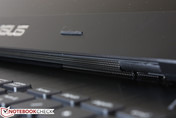
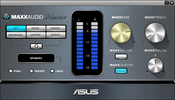
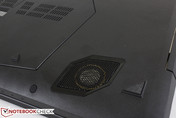
Battery Life
The G750 makes use a larger capacity 88 Wh 5900 mAh removable Li-Ion battery compared to the 74 Wh 5200 mAh battery from the G75. This is in line with the batteries of other 17.3-inch gaming notebooks such as the Valkyrie CZ-17 (87 Wh), MSI GT70H (87 Wh) and the Clevo P177SM barebones (76.96 Wh). Considering that the integrated Intel GPU is disabled on the G750, the Asus notebook will need as much juice as it can get.
Fortunately, battery runtime has improved dramatically over the previous ROG model. Idling at minimum brightness with the Battery Eater Reader’s Test returned over 6.5 hours while running on maximum brightness with the Battery Eater Classic Test returned just over 2 hours before automatic shutdown. When set to 150 cd/m3 screen brightness (setting 4/10) while looping our browser script to simulate web surfing, the notebook was able to run for a solid 4 hours.
Depending on system settings, users can expect 3 to 5 hours of light-moderate use out of the G750 before needing to recharge, which is easily double that of the abysmal battery life of the G75. Average WLAN runtime is quite good at about an hour longer than the latest 17.3-inch Clevo P177SM and P170SM barebones, but about half an hour shorter than the Valkyrie CZ-17 and MSI GT70H. It’s hard to ask for more from a high-end gaming notebook lacking Optimus.
Verdict
When we reviewed the Asus G75VW exactly one year ago, we claimed it to be one of the best high-end gaming notebooks available for the price. We can comfortably say the same yet again as the G750JW is a worthy successor to the high standards and expectations of the ROG label. However, the new series is more of an iteration than an evolution as it brings only small or expected changes to the proven formula: Haswell and Kepler updates, a slightly thinner case, better battery life, slightly rearranged ports, a larger touchpad and a single brushed aluminum panel surrounding the keyboard and palm rests. The addition of both Thunderbolt and 802.11ac WLAN makes the new series stand out against its competitors, but few users will be able to utilize them from the get go.
The fairly quiet fans definitely deserve another mention as other bulky gaming DTRs tend to be more than audible even when idling. It's a carryover from previous 17.3-inch G Series models, but so are the fingerprint-loving surfaces, the average lid rigidity, heavy weight and poor end-user serviceability. The latter is perhaps the biggest reason for enthusiasts to opt for a barebones model for easier access to all internal components and quickly swapping out the CPU and/or GPU as needed.
Nonetheless, the ability of the G750JW to maintain maximum Turbo Boost even after an hour of full system stress is impressive as are the active official ROG forums for enthusiasts and troubleshooting needs. The new G750 Series is a solid recommendation starting for $1399 - just remember to swap out the 5400 RPM SATA II HDD for an SSD ASAP.
In Comparison
| StarCraft II: Heart of the Swarm | |
| 1920x1080 Ultra / Extreme AA:on (sort by value) | |
| Asus G750JW | |
| Ibuypower Valkyrie CZ 17 | |
| 1366x768 High AA:on (sort by value) | |
| Asus G750JW | |
| Ibuypower Valkyrie CZ 17 | |
| 1366x768 Medium (sort by value) | |
| Asus G750JW | |
| Ibuypower Valkyrie CZ 17 | |
| Guild Wars 2 | |
| 1920x1080 All Maximum / On AA:FX (sort by value) | |
| Asus G750JW | |
| Ibuypower Valkyrie CZ 17 | |
| MSI GT70H-80M4811B | |
| One K73-3N | |
| Asus G75VX-T4020H | |
| 1366x768 Best Appearance Preset AA:FX (sort by value) | |
| Asus G750JW | |
| Ibuypower Valkyrie CZ 17 | |
| One K73-3N | |
| Asus G75VX-T4020H | |
| 1024x768 Best Performance Preset (sort by value) | |
| One K73-3N | |
| Sleeping Dogs | |
| 1920x1080 Extreme Preset AA:Extreme (sort by value) | |
| Asus G750JW | |
| Ibuypower Valkyrie CZ 17 | |
| MSI GT70H-80M4811B | |
| One K73-3N | |
| Asus G75VX-T4020H | |
| 1366x768 High Preset AA:High (sort by value) | |
| Asus G750JW | |
| Ibuypower Valkyrie CZ 17 | |
| One K73-3N | |
| Asus G75VX-T4020H | |
| 1366x768 Medium Preset AA:Normal (sort by value) | |
| Asus G750JW | |
| Ibuypower Valkyrie CZ 17 | |
| One K73-3N | |
| 1024x768 Low Preset AA:Normal (sort by value) | |
| One K73-3N | |
| Tomb Raider | |
| 1920x1080 Ultra Preset AA:FX AF:16x (sort by value) | |
| Asus G750JW | |
| Ibuypower Valkyrie CZ 17 | |
| MSI GT70H-80M4811B | |
| One K73-3N | |
| 1366x768 High Preset AA:FX AF:8x (sort by value) | |
| Asus G750JW | |
| Ibuypower Valkyrie CZ 17 | |
| One K73-3N | |
| 1366x768 Normal Preset AA:FX AF:4x (sort by value) | |
| Asus G750JW | |
| Ibuypower Valkyrie CZ 17 | |
| One K73-3N | |
| 1024x768 Low Preset (sort by value) | |
| One K73-3N | |
| BioShock Infinite | |
| 1920x1080 Ultra Preset, DX11 (DDOF) (sort by value) | |
| Asus G750JW | |
| Ibuypower Valkyrie CZ 17 | |
| MSI GT70H-80M4811B | |
| One K73-3N | |
| 1366x768 High Preset (sort by value) | |
| Asus G750JW | |
| Ibuypower Valkyrie CZ 17 | |
| One K73-3N | |
| 1366x768 Medium Preset (sort by value) | |
| Asus G750JW | |
| Ibuypower Valkyrie CZ 17 | |
| One K73-3N | |
| 1280x720 Very Low Preset (sort by value) | |
| One K73-3N | |
| The Elder Scrolls V: Skyrim | |
| 1920x1080 Ultra Preset AA:8x AF:16x (sort by value) | |
| Asus G750JW | |
| Ibuypower Valkyrie CZ 17 | |
| MSI GT70H-80M4811B | |
| One K73-3N | |
| Asus G75VX-T4020H | |
| 1366x768 High Preset AA:8x AF:8x (sort by value) | |
| Asus G750JW | |
| Ibuypower Valkyrie CZ 17 | |
| One K73-3N | |
| Asus G75VX-T4020H | |
| 1366x768 Medium Preset AA:4x (sort by value) | |
| Asus G750JW | |
| Ibuypower Valkyrie CZ 17 | |
| One K73-3N | |
| Call of Duty: Black Ops 2 | |
| 1920x1080 (Extra) High / On, FXAA AA:4xMS (sort by value) | |
| Asus G750JW | |
| Ibuypower Valkyrie CZ 17 | |
| MSI GT70H-80M4811B | |
| One K73-3N | |
| Asus G75VX-T4020H | |
| 1366x768 High / On, FXAA AA:2xMS (sort by value) | |
| Asus G750JW | |
| Ibuypower Valkyrie CZ 17 | |
| One K73-3N | |
| Asus G75VX-T4020H | |
| 1366x768 Medium / Off (sort by value) | |
| Asus G750JW | |
| Ibuypower Valkyrie CZ 17 | |
| One K73-3N | |
| 1024x768 Low / Off (sort by value) | |
| One K73-3N | |




